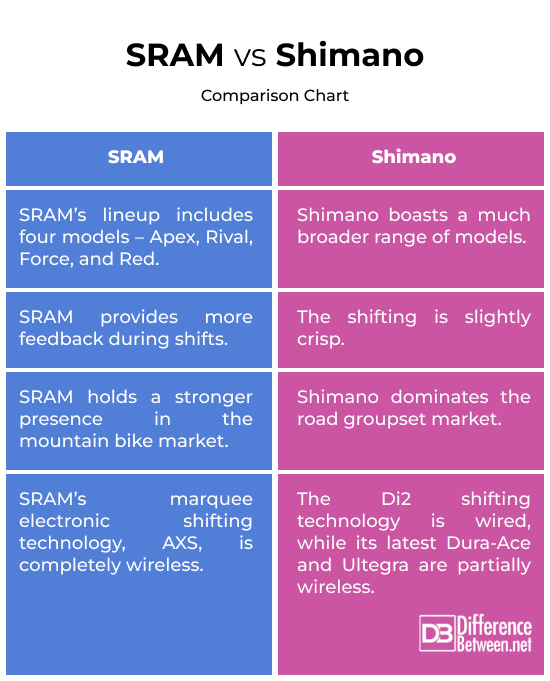Difference Between SRAM and SHIMANO
If you’re passionate about cycling, you must have heard about SRAM and Shimano. Both are among the biggest bicycle component manufacturers, specializing in drivetrains (shifters, derailleurs, cassettes, cranks, etc.) and brakes for bicycles. Both brands offer high-quality bike components, and the majority of bikes probably must have one of their drivetrains.
We break down the main differences between the two brands to help you decide which one’s better for your biking needs.

SRAM
SRAM is an American company that manufactures bicycle components; drivetrains, brakes, gravel, cranksets, cassettes, derailleurs, etc. They are globally known for their innovative drivetrain systems, including the SRAM XX1 and SRAM Eagle series. They manufacture their components in-house in the United States, Germany, and Taiwan.
The company started in 1987 and was named after its founders, Scott, Ray, and Sam. Ray is the middle name of the company’s first SEO, Stan Day.
SRAM started with a single product, the Grip Shift, a twist-style shifter for riders to change gears without taking their hands off the handlebars. This revolutionary product put SRAM on the map in the cycling industry. The success of Grip Shift fueled SRAM’s expansion. They diversified their offerings by acquiring several component companies like RockShox, Zipp, Quarq, Truvativ, TIME pedals, and more.
Today, SRAM is a leading bicycle manufacturer that is constantly pushing the boundaries with state-of-the-art technologies like wireless electronic shifting (AXS), X-DR drivers, Eagle drivetrains, and so on.

Shimano
Shimano designs and manufactures bicycle components, fishing tackle, and rowing equipment. It’s a leading Japanese multinational company and the world’s largest bicycle component manufacturer.
The company was founded in Japan in 1921 by Shozaburo Shimano. It was initially established as Shimano Iron Works on the site of a demolished celluloid factory. They initially made a mark with a new and improved freewheel. This remained their primary focus for over three decades.
They brought in index shifting in the 1980s, followed by the clickless pedal SPD system in 1990. In 2003, they introduced the “Dual Control” lever system for mountain bikes.
Difference between SRAM and SHIMANO
Origins
Shimano has been making bike components for over 100 years and has been around since 1921. SRAM is much younger than its Japanese counterpart; it got its start in 1987 in Chicago. Shimano is the world’s largest bike component manufacturer globally, followed by SRAM, which is the second-largest component manufacturer.
Model Lineup
Shimano boasts a much broader range of models, from Dura-Ace to Claris, Tiagra, Sora, Ultegra, and many more. Across the spectrum, the groupsets offer disc brakes as an alternative to rim brakes. The Shimano 105 is their most budget-friendly groupset, while the Ultegra is a performance-focused groupset.
SRAM’s lineup includes four models: Apex, Rival, Force, and Red. The top-tier groupsets—Rival, Red, and Force—are also offered in 12-speed wireless electronic versions. The company is known for their state-of-the-art technologies like AXS, Eagle drivetrains, and X-DR drivers.
Ergonomics
SRAM’s mechanical groupsets have a single lever. Their AXS lineup uses one lever on each side to shift in one direction, and pressing both levers simultaneously will shift the chainrings. SRAM provides more feedback during shifts, which allows you to feel the transition.
Shimano’s mechanical groupsets feature two movable shift levers: the brake lever and the shift lever. The Di2 electronic groupsets feature two buttons, with the brake lever being stationary. The shifting is slightly crisp, especially with the front derailleur.
Price
Talking about price, it’s safe to say that both manufacturers are fairly competitive. Both brands offer groupsets in various price segments to fit all budget buyers. That being said, Shimano’s standalone groupsets typically cost more than SRAM.
SRAM vs. Shimano: Comparison Chart

Summary
Both brands make phenomenal groupsets and dominate the bike component market. However, Shimano has been around for over 100 years and is more than twice the size of SRAM. Shimano dominates the road groupset market, with 3 out of 4 bikes using their components. SRAM, however, has a stronger presence in the mountain bike market.
FAQs
What is best, Shimano or SRAM?
Both offer high-quality components for bikes across all ranges, but their styles are different. Shimano dominates the road bike segment, while SRAM has an upper hand in the mountain bike market.
Why do people like SRAM?
SRAM is perfect for everyday riders. Their shifters often use a one-click-up, one-click-down approach, which some riders find more intuitive.
What is the difference between SRAM and Shimano cassettes?
SRAM cassettes often offer wider gear ranges (e.g., 10-52 teeth) for tackling steeper terrains, while Shimano offers various options depending on the groupset.
Can I replace Shimano with SRAM?
While it’s technically possible to mix and match components across brands, it’s not always recommended due to potential compatibility issues.
Why Shimano is the best?
Shimano remains strong in all categories. Many enthusiast riders prefer Shimano for its century-long history in the sport. Well, you have to consider your needs and preferences first before deciding.
Is SRAM heavier than Shimano?
Shimano’s mechanical groupsets are slightly lighter than SRAM’s across each category.
Does Shimano own SRAM?
Shimano and SRAM are separate companies.
Is Shimano Chinese or Japanese?
Shimano is a Japanese component manufacturer.
What does SRAM mean on a bike?
SRAM is a bicycle component company that manufactures bike components, including shifters, derailleurs, cassettes, cranks, and more.
- Difference Between Caucus and Primary - June 18, 2024
- Difference Between PPO and POS - May 30, 2024
- Difference Between RFID and NFC - May 28, 2024
Search DifferenceBetween.net :
References :
[0]Probel, Clement. “SRAM vs Shimano Road Groups: Our Guide to Help You Choose.” The Cyclist House, 19 Jan. 2023, www.thecyclisthouse.com/en/blogs/news/sram-vs-shimano-comparison.
[1]Probel, Clement. “SRAM vs Shimano Road Groups: Our Guide to Help You Choose.” The Cyclist House, 19 Jan. 2023, www.thecyclisthouse.com/en/blogs/news/sram-vs-shimano-comparison.
[2]Lin, Bruce. “Shimano vs. SRAM: Guide to Groupsets, Drivetrains, Brakes, and More.” The Pro’s Closet, 22 Jan. 2024, www.theproscloset.com/blogs/news/shimano-vs-sram#comp.
[3]Minarik, Petr. “Shimano vs. SRAM: Which One Should You Choose? An Objective Comparison.” CyclistsHub.com, 26 Feb. 2024, www.cyclistshub.com/shimano-vs-sram/.
[4]“The Eternal Question: SRAM vs. Shimano.” SportsGarage, 16 Feb. 2023, sportsgarage.net/the-eternal-question-sram-vs-shimano/.
[5]Image credit: https://www.canva.com/photos/MADpCnKnXT4-bicycle-chainwheel-parts-bike-wheel-chain-derailleur-front-shifters-cycling-road-bike-frame-/
[6]Image credit: https://www.canva.com/photos/MAEr75JITbw-blue-bicycle-wheel-with-tire/
